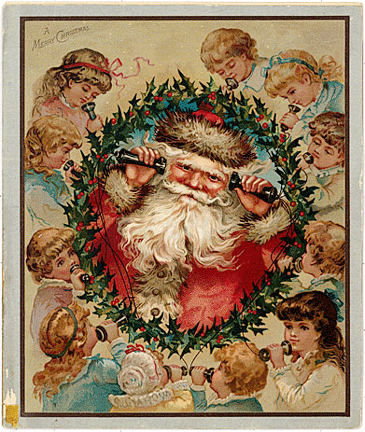 Christmas
cards have been a popular way for people to express their holiday
greetings to friends and relatives since the mid-19th century. But today
most of these cards go directly from the mantel to the trash bin after
the holiday.
Christmas
cards have been a popular way for people to express their holiday
greetings to friends and relatives since the mid-19th century. But today
most of these cards go directly from the mantel to the trash bin after
the holiday.
Christmas greeting cards were a byproduct of the cheap postal service in
Victorian-era England, when sending annual holiday letters became a
required ritual, particularly among the upper classes. As a popular
educator and arts patron (who would eventually become the first director
of London’s Victoria and Albert Museum), Henry Cole had more holiday
letters to write than most, and it was this pressure that inspired him
to create the first Christmas card in 1843.
Instead of responding individually to each of his contacts, Cole asked
an artist friend named J.C. Horsley to design him a card that could be
simply signed and mailed. The design featured a family raising a toast
at its center, with images of people helping the poor on either side.
Though other prominent Britons quickly jumped on the bandwagon,
including Queen Victoria herself, it took a few decades for Christmas
cards to become a widespread tradition.
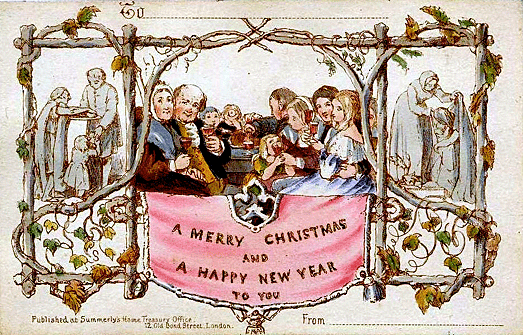
J.C. Horsley designed the first Christmas card in 1843. He placed three
separate images on the front–a large center drawing depicting a family
gathered around table toasting the holiday with wine and two side
panels, one depicting a well-dressed woman draping a cloak around a poor
woman and child, the other depicting the distribution of food among the
poor.
It took two decades for Christmas cards to catch on because, not only
had postal rates been higher, but also the post office charged the
postage to the addressee rather than to the sender. As soon as the post
office changed its policy, people began sending cards.
The first Christmas cards, modeled after Victorian visiting cards,
didn’t fold. Instead, designers created small rectangles of pasteboard,
about the size of an index card, decorated on one side with a
lithographed or etched drawing, a greeting, and blank space for the
names of both the sender and the addressee. By the 1870s, manufacturers
had started producing larger cards and folded cards. Some opened out
like cupboard doors; others fell into accordion folds.
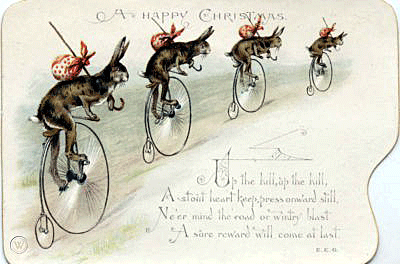 Some
of the most common images found on Victorian Christmas cards are still
familiar symbols of the holiday today–holly, ivy, mistletoe, winter
landscapes, and Christmas parties. The Victorians loved natural things
and used other images on their cards that focused less on Christmas,
such as flowers, shrubs, and trees. Animals, often portrayed as humans,
provided another popular subject for the Victorian Christmas card.
Images of children, playing with angelic expressions, also adorned many
cards.
Some
of the most common images found on Victorian Christmas cards are still
familiar symbols of the holiday today–holly, ivy, mistletoe, winter
landscapes, and Christmas parties. The Victorians loved natural things
and used other images on their cards that focused less on Christmas,
such as flowers, shrubs, and trees. Animals, often portrayed as humans,
provided another popular subject for the Victorian Christmas card.
Images of children, playing with angelic expressions, also adorned many
cards.
Since they lived during the Industrial Age, Victorians loved Christmas
cards featuring new inventions, such as the motorcar or bicycle. And
though Victorian morals frowned upon pubic sexual expression, some cards
had portraits of beautiful girls dressed in flimsy robes or partially
nude. Some cards were just downright bizarre with dark themes.
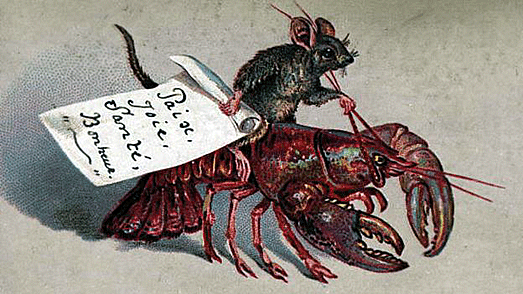
One of the strangest images found on late 19th-century Christmas cards
was a dead robin lying in the snow. Perhaps the Victorian’s obsession
with death and fondness for images that evoked pity can explain this
unique custom.
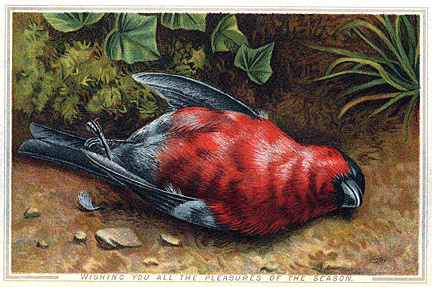
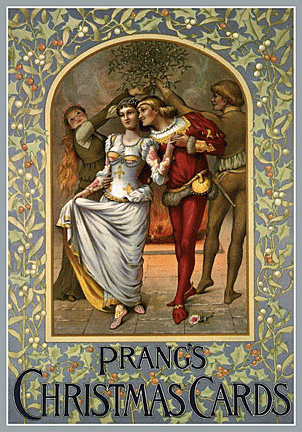 t
wasn’t until the 1870s that Christmas cards became popular in America.
Louis Prang, a German immigrant, began to turn out cards decorated with
recognizable Christmas symbols–poinsettias, ivy, and holly. His cards
grew in size as his designs became more elaborate and eventually
measured seven by ten inches. Americans loved Prang's card designs and
began collecting them. Unfortunately, Prangs cards were expensive, so
only the wealthy could afford to buy them.
t
wasn’t until the 1870s that Christmas cards became popular in America.
Louis Prang, a German immigrant, began to turn out cards decorated with
recognizable Christmas symbols–poinsettias, ivy, and holly. His cards
grew in size as his designs became more elaborate and eventually
measured seven by ten inches. Americans loved Prang's card designs and
began collecting them. Unfortunately, Prangs cards were expensive, so
only the wealthy could afford to buy them.
Mass-produced Christmas cards took a leap forward after a Kansas City
printing company founded by Joyce Hall and his brothers created their
first holiday design in 1915. Instead of the traditional postcard style,
the company switched to folded or book-style greeting cards that would
be mailed in an envelope.
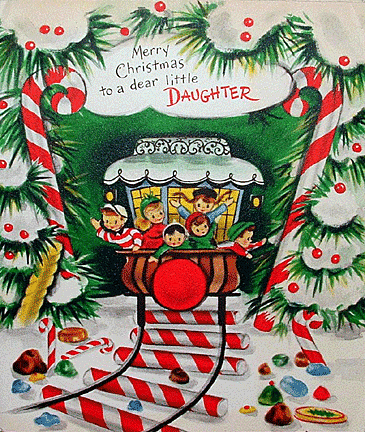 The
innovative design stuck, and Hall Brothers grew into Hallmark, one of
the largest card companies in the world. The company eventually used its
clout to commission Christmas cards from famous artists like Norman
Rockwell in addition to its staff of designers. President Dwight D.
Eisenhower personally consulted with Joyce Hall before issuing the first
official White House cards, which featured a portrait of Abraham
Lincoln—painted by Eisenhower!—in 1953.
The
innovative design stuck, and Hall Brothers grew into Hallmark, one of
the largest card companies in the world. The company eventually used its
clout to commission Christmas cards from famous artists like Norman
Rockwell in addition to its staff of designers. President Dwight D.
Eisenhower personally consulted with Joyce Hall before issuing the first
official White House cards, which featured a portrait of Abraham
Lincoln—painted by Eisenhower!—in 1953.
As the turn of the 20th century approached, Americans often exchanged
small gifts with their friends. By the 1920s, however, the price of
Christmas cards had fallen enough so that many people began giving or
sending cards instead. Today, American greeting card companies sell more
cards for Christmas than any other holiday. But with the continual rise
in postage rates and the cost of cards, themselves, more people,
unfortunately, are choosing not to send them.
What to Look for in Old Christmas Cards
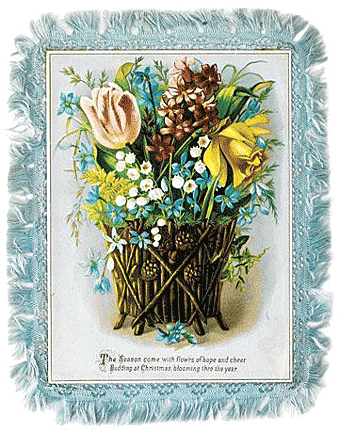 It's
no surprise then that some of the most valuable cards today are also the
oldest.
It's
no surprise then that some of the most valuable cards today are also the
oldest.
"Christmas cards are something called emphera, so they were designed to
be used for only a short time," Richard Davies, Head of Content for
online collectibles marketplace AbeBooks.com, tells GoodHousekeeping.com.
"The older the postcard, the less likely it is to have survived, so
pre-1900s postcards are hard to find."
The clearly identified date and topical content on this Christmas card
add to its value. Some cards will have the year printed on the front or
the back, but motifs can also help date the card. Popular themes of the
era included flowers, robins, and personified animals in general.
Collectors look out for cards that tell a history, such as content
alluding to a war or topical event, or even a popular toy of the time.
Evidence pointing to a specific date can add to the card's provenance.
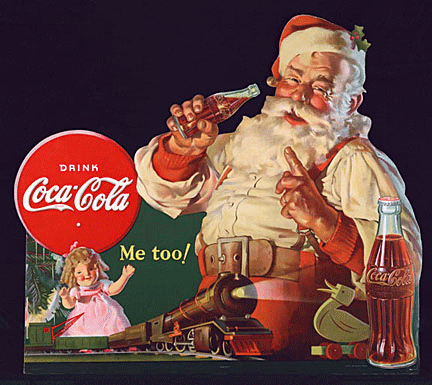
Santa's look and demeanor has changed a
lot over the years, but he's remained popular among buyers. Before
Coca-Cola helped popularize our notion of Santa today, he often wore a
green coat, or had elfish features instead more jolly ones.
Condition matters now more than ever, as buyers frequently demand
near-mint status. The ideal scenario is a card that's sat forgotten (and
protected) in box for years, as it's less like to have rips, tears,
fading, or other damage.
< Back to Collecting Archives
Next Article >
